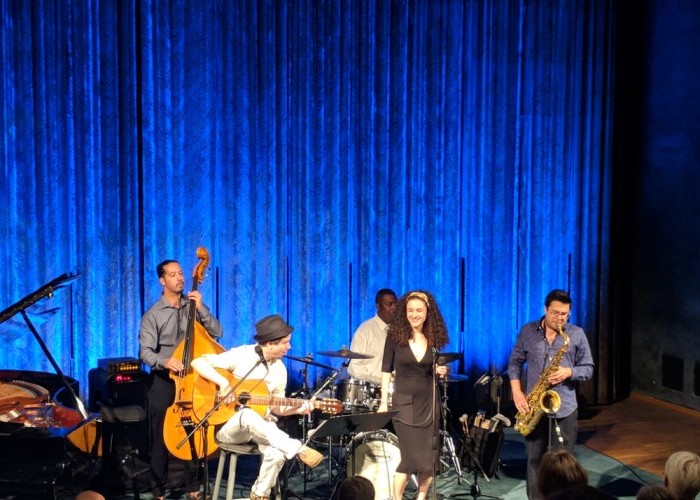Dec 9, 2025 12:28 PM
In Memoriam: Gordon Goodwin, 1954–2025
Gordon Goodwin, an award-winning saxophonist, pianist, bandleader, composer and arranger, died Dec. 8 in Los Angeles.…

Daniel Rolim and and Marta Freitas perform at Brazilian Jazz Night during the 40th annual Copenhagen Jazz Festival.
(Photo: Suzan Jenkins)Drowsily easing up to passport control upon arrival in Copenhagen after a sleepless, otherwise pleasant 8-hour journey from Washington, D.C., the Danish agent examines my paperwork, peering up to ask the nature of my trip.
“I’m here for the jazz festival,” I said, eliciting enthusiastic approval.
Boasting more than 1,300 performances across 120 venues, the 40th annual Copenhagen Jazz Festival opened July 6 with two engaging, slightly madcap bands on the lawn at Kongens Have, Copenhagen’s oldest public park. Opening 9-days of free matinee park performances on a 75-degree afternoon were the zany, brass-laden unit billed as The Traditional Eclectic Multi-Generational Jazz Ensemble, its leader decked out in green shorts and a multi-colored straw hat. Guitarist Pierre Doerge’s New Jungle Orchestra followed, featuring the tart trumpet of Kirk Knuffke, the first in a succession of American guest soloists. The troupe opened with “Caravan” in proper Saharan mode, polyphony draping the bridge.
Near to the park, the jazz specialty record store/coffee shop Jazz Cup beckoned with the Snorre Kirk “Nordic Quartet,” essaying some Ellingtonian blues. The jazz takeover of this marvelous city was underway.
That evening, the first of six performances at DR Koncerthuset—a hall that looked as if it was a cross between an affluent mega church and an exquisite opera house—delivered Brad Mehldau’s trio. In complete simpatico with bassist Larry Grenadier and drummer Jeff Ballard, Mehldau’s poetic piano was on vivid display. The bandleader has a splendid interiority complex, a sense of inner-space architecture that proved ideal for a Danish audience keen on exquisite design. A gracious navigator, Mehldau consented to two encores that characterized the breadth of his abilities and included Billy Roberts’ “Hey Joe,” then Sam Rivers’ indelible “Beatrice.”
Saturday afternoon’s visit to Designmuseum Denmark inevitably led to the National Museum for one of several 6 p.m. performances curated by pianist Nils Lan Doky, this one featuring former Copenhagen resident and master drummer/humorist Albert “Tootie” Heath. At 83, he’s as crafty and cunning on the traps as anyone. Leading a quintet, the facile Doky called hard-bop themes, appropriately including some Jimmy Heath works.
Barking dogs from a day of walking mandated lingering around the museum for the 8:30 p.m. Brazilian Jazz Night, featuring the charming duo of guitarist-vocalist Daniel Rolim, vocalist Marta Freitas, as well as the relaxed mastery of expat drummer Victor Jones. Particularly notable was the brawny tenor saxophone of Hungarian expat and current Copenhagen resident Gabor Bolla, with Doky, Heath and the Brazilian performers. Rolim and company beguiled through a mixed bag of Jobim, Nascimento, Gilberto Gil and his own originals.
Sunday afternoon’s trek toward the park for one of several homages to U.S. expatriates who brought jazz to Copenhagen turned up the Jan Harbeck Quartet celebrating Ben Webster a mile from the tenor titan’s final resting place. A detour back to Jazz Cup offered a set by Berklee-educated Japanese pianist Makiko Hairabayashi, and walking back to Hotel Kong Arthur provided some passionate tenor saxophone: George Garzone, completing his set at Kaby’s. Copenhagen was awash in jazz.
That evening at Jazz by the Sea, on a concrete pier festooned with picnic tables and open space to encourage dancing, the regal vocalist-guitarist Rokia Traore’s hypnotic Mali grooves seeped up from the soil, providing a subtle lift to the feet, her story-weaving voice amping in intensity with each piece. Clearly hers was music favorably experienced under the splendid open Danish sky with its summertime sunsets.
Spanish percussionist Jorge Rossy played a series of delightfully informal trio sets at the minuscule café Gaarden og Gaden. The joint was wall-to-wall patrons engaged by the dry ice nature of Rossy’s vibes playing, reminiscent of Walt Dickerson’s vibrato-dampening approach to the mallets.
The visit was capped off by some UK skronk, conveyed by the boisterous Sons of Kemet. Tenor man Shabaka Hutchings, sporting a prodigious gold medallion, tossed aside his floppy hat as his steam-drill tenor hurtled into ecstaticism on the launch pad of lips-of-steel tubaist Theon Cross and twin drummers. The band’s asphalt-thick grooves proved irresistible to the crowd at a studio space inside DR Koncerthuset. Sons of Kemet’s funky uppercuts were an apropos conclusion to a week that began with the poetic swing of the Brad Mehldau Trio. DB

Goodwin was one of the most acclaimed, successful and influential jazz musicians of his generation.
Dec 9, 2025 12:28 PM
Gordon Goodwin, an award-winning saxophonist, pianist, bandleader, composer and arranger, died Dec. 8 in Los Angeles.…

Belá Fleck during an interview with Fredrika Whitfield on CNN.
Jan 13, 2026 2:09 PM
The fallout from the renaming of the John F. Kennedy Center for the Performing Arts to include President Donald…

Flea has returned to his first instrument — the trumpet — and assembled a dream band of jazz musicians to record a new album.
Dec 2, 2025 2:01 AM
After a nearly five-decade career as one of his generation’s defining rock bassists, Flea has returned to his first…

Dec 11, 2025 11:00 AM
DownBeat presents a complete list of the 4-, 4½- and 5-star albums from 2025 in one convenient package. It’s a great…

“It’s a pleasure and an honor to interpret the music of Oscar Peterson in his native city,” said Jim Doxas in regard to celebrating the Canadian legend. “He traveled the world, but never forgot Montreal.”
Nov 18, 2025 12:16 PM
In the pantheon of jazz luminaries, few shine as brightly, or swing as hard, as Oscar Peterson. A century ago, a…